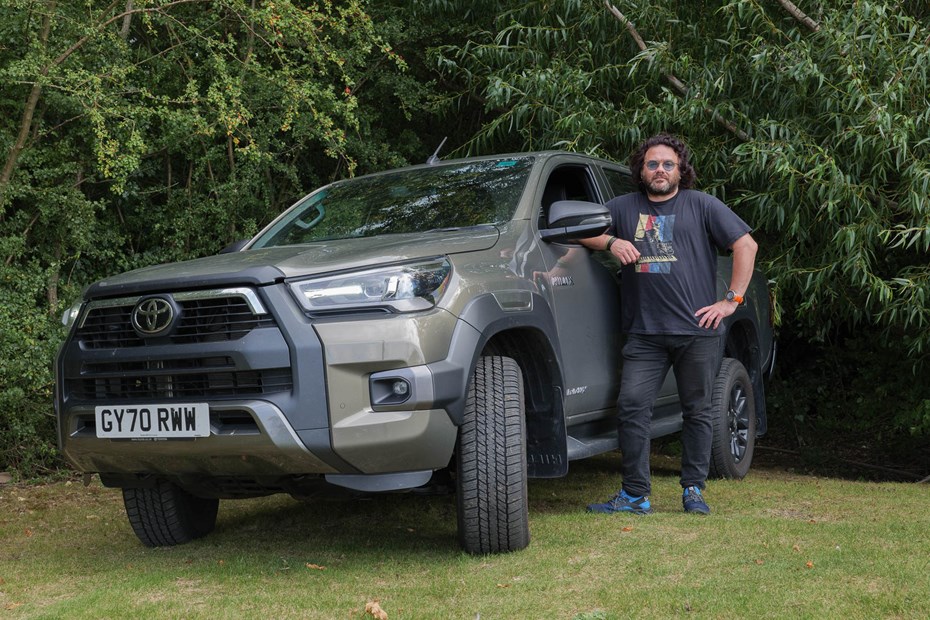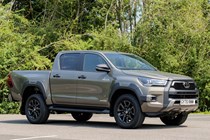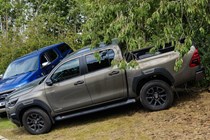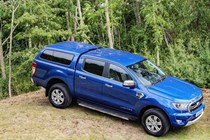Long-term test review of the Toyota Hilux Invincible X.
Update 3: Invincible X vs Ranger Limited
If the Hilux Invincible X is Toyota’s pickup glow-up, it’s more of a weekend makeover compared to the changes the Ford Ranger has undergone. Yet this is the vehicle the Invincible X needs to turn buyers away from, more so than in the commercial, utilitarian range where the Hilux has some advantages over stripped-out Rangers.
Due to be replaced next year, the Ranger’s ten-year run in this generation has seen it go from a rather crude (if versatile) chunky truck to the sort of refined family hauler that Mercedes should have been able to produce in the X-Class.
Most obvious of those changes is the frankly incredible Ranger Raptor. For a £50,000 toy it’s deeply convincing as a rugged family vehicle, as editor CJ has discovered during a year of long-term testing. But the Raptor isn’t the one most people buy, and it’s technically very different to the regular Ranger.
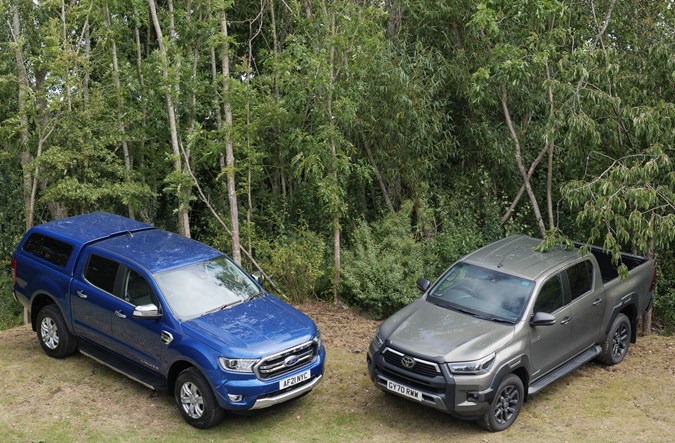
For the same price as the Hilux Invincible X, I could have a Ford Ranger Limited with accessories, or a Wildtrak if pushed to spend a little more. The Limited is the more mainstream version and it’s a very fair comparison.
Ford’s cabin feels vast, yet intimidating next to the simplicity of the Hilux. Huge, squashy seats aid comfort, and the square and imposing dashboard carries the stamp of America’s truck experience as well as Ford’s ergonomic skills.
Wildtrak models include lavish stitched leather-effect trim, but the Limited’s charcoal plastics aren’t exactly uninviting. Toyota scores a point here for having readable, tactile heating controls; the Ranger’s push-buttons are hard to see and harder to find just by touch.
Comparing gearboxes is unfair here as my Hilux’s manual gearbox is up against a Ford auto, but pickup manual gearboxes generally share similar traits, whereas the automatic options are very different. Ford’s 10-speed auto is extremely good, Toyota’s automatic is extremely robust, but feels old-school by comparison. Personally, I like both, having experienced the 2.8-litre and auto combo in a Land Cruiser and found it effortless.
Hilux: big, yet nimble
Behind the wheel, the Ranger feels much larger, harder to place on narrow country lanes and very remote, rubbery and heavy. It’s not actually that much bigger or heavier, but the slower steering has a lot of damping (to remove the vibration earlier Rangers displayed) which isolates the driver from the road surface.
It’s not the only thing that’s well-damped. Whether the 2021 Ranger benefits from lessons learned developing the Raptor is hard to tell, but it rides remarkably well on road now and I don’t remember it being this good in 2018.

The front end of the Ranger may not be easy to place with precision, but it’s very relaxing to drive over long distances.
By comparison the Hilux is sharp, responsive, but wriggles over rough surfaces and you’re always holding the wheel in place, just enough tension to make motorway driving a little less relaxed.

Although the Hilux shimmies less than it used to, and handles better, the trade off is a curiously firm ride sometimes. It very much depends on the road surface, but it’s very much the boy racer’s pickup, cornering flat, but somewhat unforgiving.
Off-road, the Hilux’s firm suspension means slow speeds can still be jarring. The Ranger’s squashy, floaty suspension is rather less instrusive, but can also hide things you might want to know about on unfamiliar lanes.
Ranger: a 4x4 pickup for the motorway
And all this is before considering the Ranger’s feature list, which extends to active noise cancelling, one of the best infotainment systems you’ll find in a commercial vehicle, and even details like the assisted tailgate (the Hilux tailgate is heavy and undamped even on this high-spec model, something that can be rectified for around £200).
On paper the Ranger is a better lifestyle pickup. Toyota hasn’t really bothered with this market much in the past, preferring to deliver hard working off-roaders, so the Invincible X is almost a first attempt at a luxurious Hilux for the UK market.
Subjectively it’s very easy to like the Toyota though; the sharp and agile performance, unusually stylish sweeping dashboard, and ruggedised details of the Invincible X’s bodykit are all highly appealing.
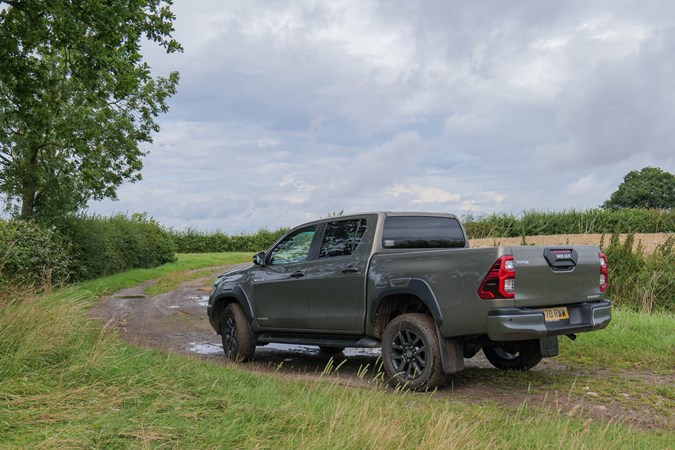
They pale beside the Hilux’s trump card, though – a 10 year, 100,000 mile warranty. If a pickup is for life, not just for leases, Toyota’s got that long-term ownership in mind. With less than a decade before the end of sales of combustion-engine cars in the UK the Hilux could be the only vehicle you need, particularly if you prefer nimble, communicative cars.
Update 2: About the Power button…
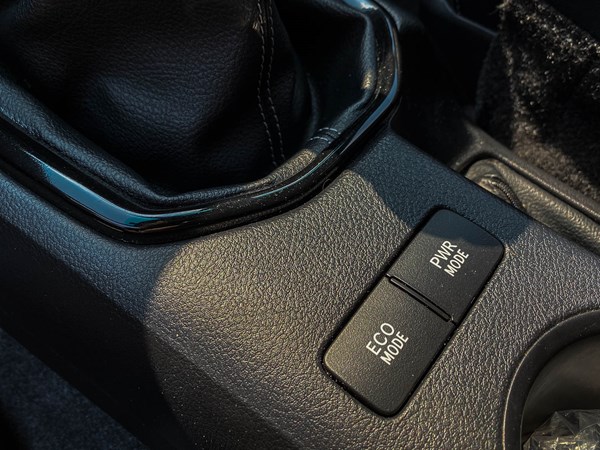
Normal Toyota Hilux pickups have a power button, but with a 150hp engine, it is hard to grasp why you’d ever switch it off. With the new 2.8-litre engine, you switch it on at your peril with the manual gearbox.
I’m not entirely sure what the technical differences are – if it’s genuinely releasing more power, or just changing the throttle calibration, but unladen in second and third gear you can really feel the full shove of 500 Nm; in first gear it’s almost too unruly, needing feather-soft inputs. No wonder it defaults to off.
Of course there’s a lot more to how a pickup drives than just the acceleration. Toyota claims to have done a lot with the Hilux’s chassis to improve refinement with the Invincible X, and it’s definitely better than previous models. It’s still short of being refined, though.
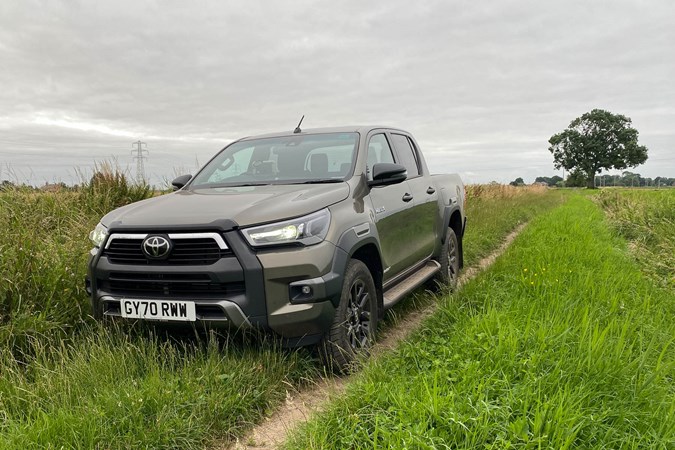
What it does do well is provide consistent feedback, which is useful when driving off-road or towing as well as making it rather fun when making use of that power button on rural roads. The Hilux has excellent steering, perfectly weighted and not numb or remote feeling, and the rather firm suspension helps it feel quick and secure.
One of the reasons I prefer ‘lifestyle pickups’ to similarly-priced SUVs is the old-school mechanical feel that with a manual gearbox, evokes happy memories of bouncy, eager rear-wheel drive Fords, Opels and Vauxhalls from when I first started driving. Yeah, I’m old. This feel is gradually being eradicated from newer models as pickups become more refined and user friendly, and the Hilux strikes a particularly good balance by offering adaptive cruise control, lane keeping and features like rev-matching manual shifts, but keeping that direct connection from driver to wheels.
Subjectively, it’s very much to my taste. Objectively – it’s interesting to see how it compares with the UK’s best-selling pickup…
Update 1: Welcome to the (sparsely populated) Jungle
When the eighth-generation Hilux arrived in the UK in 2016, the pickup market was picking up dramatically. It faced remarkably competent rivals such as Mitsubishi’s refreshed L200, the extensively uprated Ford Ranger and the relatively new Amarok, battling for sales alongside the erstwhile Nissan Navara, just as Fiat joined the fray with a rebadged L200 and Mercedes followed suit with the X-Class.
All had their flaws, and their benefits, but with such a competitive market it comes down to survival of the fittest.
Now there are just four pickups officially on sale in the UK; dividing a niche customer base between more players and stronger emissions controls has resulted in the less successful models dropping off the radar.
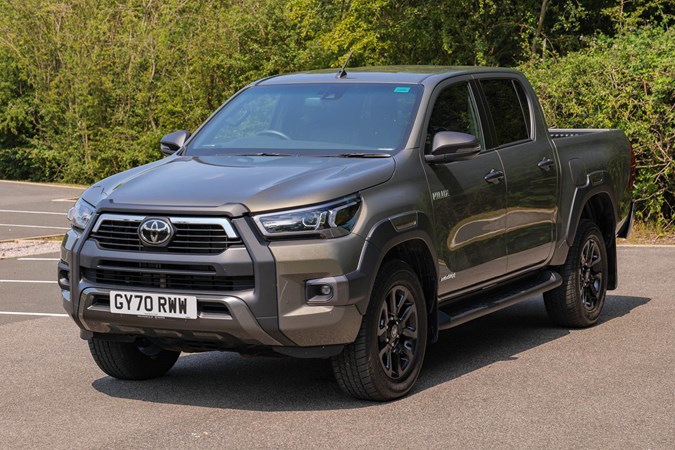
Until the introduction of the 2.8 diesel, the Toyota Hilux looked very much like it would follow suit as a lifestyle pickup – surviving on brand strength rather than technical wizardry or refinement. A series of upgrades targeted at the flashier end of the market has ensured it’s not only still available, but on paper, competitive in the world of double cab one-tonne 4x4 pickups.
We have the top of the range 204hp 2.8-litre Invincible X in manual form; a competitively priced alternative to the Ford Ranger Wildtrack, SsangYong Musso Saracen or Rhino, and the Isuzu D-Max V-Cross.
Toyota’s websites promote the Hilux alongside cars as a lifestyle vehicle with prices including VAT, but for comparison with rivals this particular example costs £33,574.16 without tax, including metallic paint.
Here’s what you could have instead (prices correct at time of writing):
>> An Isuzu D-Max V-Cross, with 164hp – £31,759 (inc. £500 for metallic)
>> A Ford Ranger Wildtrack with 213hp and driver assistance – £33,350 (inc. £1,725 for options)
>> A SsangYong Musso Rhino LWB – £30,930 (inc. £575 for metallic)
All can tow 3.5 tonnes, with leaf sprung back axles, all except the Rhino are manual (automatics are available at extra cost on the others) and all feature comparable trim, infotainment and passive safety features.
(If you miss the coil-sprung comforts of the Navara/X-Class, the SWB Musso still features coils, as does the Ranger Raptor).
SsangYong lags behind rivals slightly in provision of active safety, but all are considerably better than pickups were five years ago. The Musso is the only one to deviate in terms of technical capability – it can carry a full payload and tow to full capacity at the same time, and it has an appreciably bigger load area (with the downside that you will take up two spaces at the supermarket).
Toyota’s biggest on-paper advantage over rivals is a 10-year, 100,000 warranty which also applies to used Hiluxes, with SsangYong’s seven-year, 150,000 mile coverage a close second.
It’s a tough, tough call between these tough trucks, and at least in terms of the brands, Toyota’s always been seen as a sensible choice rather than the in-your face aggression of the Ranger or the ‘in-the-know’ fan loyalty of the D-Max.
Sensible is cool these days. And the technical argument against the Hilux has been whipped away like a tablecloth in a magician’s show, leaving the full spread of 2.8-litre torque intact atop wide arches, a muscular facelift and some shiny lights.
Toyota’s lifestyle truck is now ready for the motorway as well as the bridleway, and we’re going to test it out…

Just so you know, we may receive a commission or other compensation from the links on this website - read why you should trust us.


